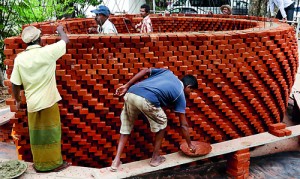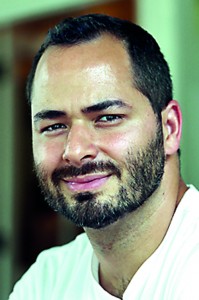Brick by brick, life and death
Surrounded by masons at work, Tristan Al-Haddad is laying bricks. His white t-shirt isn’t quite as pristine as it was a few hours ago, his hands are coated in dust, grime and sweat beads on his brow. People driving by on Horton Place need only glance over into the grounds of the Lakshman Kadirgamar Institute for International Relations & Strategic Studies (LKIIRS) to catch a glimpse of what Tristan and his team of local artists and bricklayers are labouring over for the Colombo Art Biennale–it’s titled Womb/Tomb.

Womb/Tomb: The creation in the making
Dusting off his hands, Tristan takes us on a circuit of the structure – it swells and folds in odd, impossible ways, seeming to have been frozen in mid-breath almost. (“Masonry doesn’t really want to do this,” says Tristan.) Little chalk markings on the brick indicate that there is more effort to this than meets the eye – the lines of the structure, designed in response to the space, had to first be carefully plotted on the computer and even now the placing of each brick requires individual attention. “The project is a study in contradiction, because on the one hand it is about the most basic technique of building, on the other hand this is a highly computationally designed piece. The entire thing was modelled using very sophisticated models, every brick was modelled in the computer before it was ever built,” says Tristan.
It’s still very much a work in process when the Sunday Times is allowed an exclusive peek, and so the small interior is not yet considered safe for visitors. When it is done though, it will speak in its own poetry: an aperture in the roof will allow a shifting spotlight to light the interior; a second aperture, in direct line of sight from the steps into the centre’s main office, will allow people to enter into the space. Tristan hopes that anyone who steps in will feel almost as if they are being embraced. As architectural metaphors go, it speaks to the way we come into the world, and the spaces beyond to which we depart, infinite and unknowable; experiences, perhaps the only ones, which none of us are exempt from.
Tristan has been working closely with a local team of 17 (including artist Pathum Gamage) and says that process itself feeds his creativity: something essential was gained in between the moment where he showed them what he refers to as the “the rhythm, the geometry, the pattern” of the piece and work beginning on the actual structure.
“Really, what was very important for me when I was invited to participate in the Biennale was to come and to work with local craftspeople, to respond to the local context and to work with local material that made sense in the historical continuum of the place.” In that light, brick was hard to beat: “Brick is an almost primitive material, it is the earth, shaped and stacked. How can you take such a humble material and shape it into something absolutely beautiful?”

Tristan Al-Haddad
As an artist who is also an architect and a designer, Tristan loves to play with objects that one can interact with and that change the viewer’s perception of space: “It’s important that it can actually cause a visceral reaction; that it doesn’t just make you think but makes you feel something.”Projects like this are interesting and further blur the very thin line between what Tristan perceives as art and architecture.
His large scale sculptures (which currently include a work in progress – a 100m long sculpture that is the size of an entire city block in Dallas, Texas) are particularly difficult to categorize. A previous sculpture was an outsized Mobius strip. It’s a trait evident again in the Dallas sculpture which is cleverly titled Allotrope, as in allotropy, the property of some chemical elements to exist in multiple forms. To earn its name, his enormous sculpture starts out in one form before it burrows into a large building, coming out the other end a different shape. Science is made art and vice versa, in his work.
An assistant professor at the School of Architecture at the Georgia Institute of Technology, Tristan has a particular interest in Digitally Augmented Making and the relationship between advanced technology and design. Here under the U.S. Department of States Cultural Envoy Program, chosen from the American arts community to serve as cultural ambassadors to the world, he has a packed schedule with multiple talks at universities and institutions and presentations that are a part of the Biennale programme.
- S.D.
| Tristan will be featured in the Colombo Art Biennale session ‘Between material and immaterial worlds’ tomorrow, February 3 at 4 p.m. at the LKIIRS.
|


